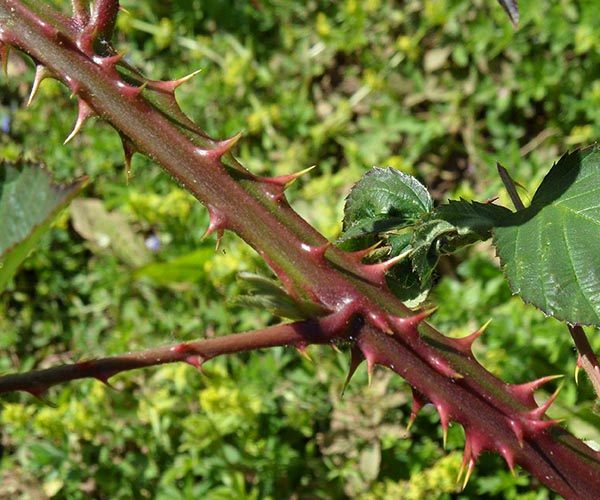
Rubus milfordensis – Series Rhamnifolii
back to Alphabetical index · Taxonomic index
This British endemic is quite easily recognised by its very large, showy pale pink flowers. It is mainly a species of heathlands and wood margins. The flowers have very long stamens which give them a striking similarity to Rubus leightonii, but being a member of the Rhamnifolii it has no stalked glands on the stems, the leaflets are grey felted below and it is one of several members of the group with almost unarmed floral branches, although the stem prickles are long and moderately stout. Its distribution is centred on Surrey, West Sussex and north-east Hampshire but is has also occurred in Bucks and Essex.

It tends to have a tall, climbing habit. Panicles are long and broad, but the upper flowers are short-stalked. Note the relatively few, fine prickles in the photo below. It is very similar to another endemic R. londinensis, which has a distribution mainly east of London, Essex and East Anglia. That has almost no prickles in the upper part of the inflorescence and different shaped leaves.

Flowers exceed 3cm across (petals 15mm long) and are various shades of pink or nearly white. The petals are usually slightly notched. Styles are yellowish-green. Sepals are short or sometimes long-pointed and reflexed after flowering.


The terminal leaflet is relatively large (about 9cm long), elliptical to somewhat obovate (wider above the middle) when well developed. The margins are rather finely serrated and the base is shallowly cordate.




Leaflet undersides are greyish-green felted, at least when young.


Stems are usually bluntly angled, thinly hairy but often shining, and turn a dull reddish-brown or maroon in full sun. Scattered short-stalked glands are rarely present. The brighter purple and yellow prickles are often patent (perpendicular to the stem) or slightly declining and sometimes kinked.



